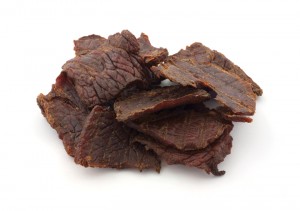There’s a wide world of jerky beyond the vacuum-packed gas station treats, and the journey starts in your oven.
Once reserved for cowboys, campers and road-trippers, jerky’s successfully moved from lowbrow to gourmet. For proof that the leathery slabs have officially entered the gourmand’s radar, look no further than the pineapple-orange beef and lemon-garlic organic turkey strips from Sonoma, California’s Krave Jerky, launched in early 2010. Chef John Schenk of New York City’s Strip House serves his version marinated in oyster sauce, rice wine vinegar, lime and spices, then deep-fries the jerky in goose fat. New Jersey operation Slant Shack Jerky offers the ultimate in bespoke protein: Connoisseurs can commission 1/4 to 1-pound batches of jerky by choosing their own meat, marinade, rub and glaze. The differences between these epicurean strips and those gas station jaw-grinders are meat quality and flavor profile—and little else. Jerky’s biggest secret? How astonishingly simple it is to make yourself.
DIY jerky begins with a lean cut of meat; fat hampers the drying process, so start with a sizeable hunk of beef round and ask a butcher to trim it well. Other firm meats work, too; turkey breast, venison, bison and salmon make hearty canvasses for experiments in marinades. Your soak will determine your jerky’s profile: Add citrus juice and brown sugar, and you’ll get tropical jerky with a bit of tang, or stay traditional with savory Worcestershire and garlic. Transforming raw, marinated meat into jerky is as easy as setting an oven; low heat slowly dries (but doesn’t cook) meat. Remove jerky when it’s dry but chewy, and savor the artisan side of the once lowly snack.
4 STEPS TO JERKY:
1. CUT
Using 21/2 pounds of lean beef top round or bottom round 1 to 2 inches thick, slice the meat into thin slabs about 1/8-inch thick, cutting with the grain. Keep the meat cold or frozen for easy slicing.
2. MARINATE
In a large plastic storage bag, combine 2/3 cup each of soy sauce, Worcestershire sauce and dark or amber lager, plus 2 tablespoons cracked black pepper, 1 tablespoon salt and 1/2 tablespoon each onion powder and garlic powder. Optional: Add 1 teaspoon liquid smoke or 1 tablespoon sesame seeds for savory jerky; 1 tablespoon brown sugar or honey for sweet jerky; or 1 tablespoon hot sauce, Adobo sauce, red pepper flakes or cayenne pepper for spicy jerky. Add the beef slices to the bag, seal and marinate, refrigerated, 3 to 6 hours.
3. DRY
Line the lower rack of an oven with foil and preheat to 200 degrees. Remove the beef from the marinade, pat dry and arrange the slices on the oven’s wire racks. Dust with black pepper and bake 5 to 8 hours, until jerky is firm and dry but not brittle.
4. STORE
Keep jerky in an airtight container, refrigerated or frozen, for up to 6 weeks.

